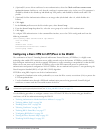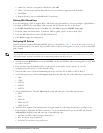
274 | VirtualPrivateNetworks DellPowerConnectW-SeriesArubaOS6.2 | User Guide
VPN Client RAP psk RAP certs CAP
External AAA server 1 External AAA server 1 Not supported CPSEC-whitelist
External AAA server 1 External AAA server 2 Not supported CPSEC-whitelist
LocalDB LocalDB LocalDB-AP CPSEC-whitelist
LocalDB External AAA server 1 Not supported CPSEC-whitelist
Working with Certificate Groups
The certificate group feature allows you to access multiple types of certificates on the same controller. To create a
certificate group, use the following command:
(host) (config) #crypto-local isakmp certificate-group server-certificate server_certificate
ca-certificate ca_certificate
You can view existing certificate groups using:
show crypto-local isakmp certificate-group
Working with VPN Authentication Profiles
VPN Authentication profiles identify a user role for authenticated VPN clients, an authentication server, and the
server group to which the authentication server belongs. There are three predefined VPN authentication profiles:
default, default-rap and default-cap. These different profiles allow you to use different authentication servers, user
roles and IP pools for VPN, remote AP and campus AP clients.
NOTE: The default and default-rap profiles are configurable, but the default-cap profile cannot be edited.
Parameter default default-rap default-cap
Default Role for authenticated users default-vpn-role default-vpn-role sys-ap-role
0
Maximum allowed authentication failures
(The number of contiguous authentication
failures before the station is blacklisted.)
0 (feature is disabled) 0 (feature is disabled) 0 (feature is disabled)
Check certificate common name against
AAA server
disabled enabled enabled
Authentication server group internal
Table 77:
Predefined Authentication Profile settings
To edit the default VPN authentication profile:
1. Navigate to the Configuration > Security > Authentication > L3 Authentication page.
2. In the Profiles list in the left window pane, select the default VPN Authentication Profile.
3. Click the Default Roledrop-down list and select the default user role for authenticated VPN users. (For detailed
information on creating and managing user roles and policies, see "Roles and Policies" on page 296.)


















